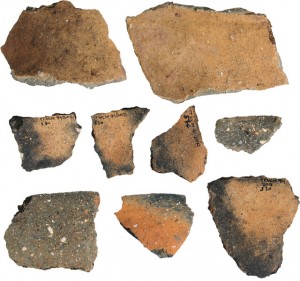13 December 2013
Scientists developing dating method based on Earth’s ancient magnetic field

Scientists may be able to accurately determine the age of remnants of clay pots and tools when carbon dating and archaeological methods can’t help. Credit: Wessex Archaeology
Cassette tapes or eight-tracks might be the first things that come to mind when thinking about dated magnetic storage, but Bronze Age clay pottery has them both beat. Using information stored in the clay’s magnetic minerals, scientists are developing methods to determine how old these artifacts are when other dating methods come up short.
Carbon dating is a widely-used technique for determining the age of archaeological discoveries, but the method only works on artifacts made from carbon-containing organic matter, like wood or cotton. For clay pottery, archaeomagnetic specialist Michele Stillinger of the University of Minnesota, Minneapolis showed that a magnetic method might work.
At Thursday morning’s poster session at the American Geophysical Union’s Fall Meeting in San Francisco, Stillinger presented her recent work showing a technique that accurately predicted the age of multiple Syrian pots from 2300 to 1000 BCE. The key is that the clays contain magnetic minerals, like hematite and magnetite.
“They’re like little compasses inside the clay,” Stillinger said.
These mineral compasses were pointed in random directions before the pots were put inside a kiln. But as the Bronze Age potters heated the clay, the compass needles turned and began aligning with the geomagnetic field, or the Earth’s magnetic field. When the pottery cooled, this alignment was frozen in place, preserving information about the geomagnetic field.
Today, Stillinger can take these samples to her lab and reheat them slowly. By applying a well-defined magnetic field, she and her colleagues observe how the compasses within the clay reorient with the new field at different temperatures. They use these observations to decipher how strong the Earth’s magnetic field was when the pot was first made.
The final step is finding at what point in history the preserved strength matches the Earth’s field strength. Scientists are currently working on plots that show this field strength over the last several millennia in different regions around the globe, but they must incorporate other dating techniques to corroborate their findings.
“It’s work in progress,” said geologist Ron Shaar of the Scripps Institution of Oceanography. Shaar presented a poster that detailed his investigation of the historical geomagnetic field in the Levant, a region in the Middle East. “The best way to address this problem is go to sites where you can date with a very high degree of precision.”
He is part of a team working to identify the age of a variety of artifacts with an array of techniques, including carbon dating and tree-ring dating. The team then extracts magnetic information from objects whose ages are well known to create a reasonable picture of the Earth’s magnetic field at the time the artifact was created. The group has already made nearly 72,000 such measurements. From this, they can fill in the plot, or curve, of the Earth’s magnetic field strength over time.
“Our main job is to build an archaeomagnetic curve for dating,” said Shaar. A curve would help Stillinger and others determine the age of artifacts with greater accuracy. But he said they must continue generating new data to make this method reliable. “There’s no other choice but to invent the wheel.”
– Matt Davenport is a science communication graduate student at the University of California, Santa Cruz



 GeoSpace is a blog on Earth and space science, managed by AGU’s Public Information staff. The blog features posts by AGU writers and guest contributors on all sorts of relevant science topics, but with a focus on new research and geo and space sciences-related stories that are currently in the news.
GeoSpace is a blog on Earth and space science, managed by AGU’s Public Information staff. The blog features posts by AGU writers and guest contributors on all sorts of relevant science topics, but with a focus on new research and geo and space sciences-related stories that are currently in the news.
Founds many shards in WI field. Need help confirming native or pre.
My email address is [email protected]